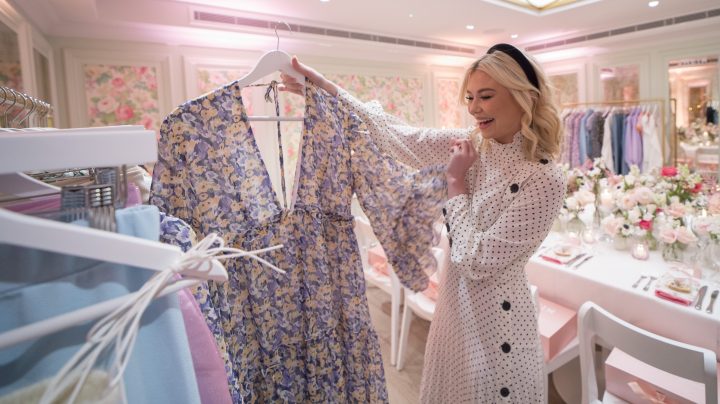
Is fast fashion catching up to real time?

As consumers continue to demand faster and cheaper goods, China-based online clothing brand Shein is pioneering an even faster model of fast fashion — and it’s skyrocketing in popularity.
Shein’s website ranks first in the world for web traffic in the fashion and apparel category, ranking ahead of legacy brands including Nike, Zara and Macy’s. A recent report also ranked Shein as “the most talked about brand on TikTok” in 2020.
Matthew Brennan writes about Chinese technology companies. He said Shein is the fastest-growing e-commerce company in the world, and the company relies on a model called real-time fashion, which cuts the time from design to production to as little as a few days.
“For fast fashion, speed is really important, and if you’re able to quickly spin up when an item is doing well, that gives you a sustainable advantage over your competitors,” Brennan said.
Brennan spoke to “Marketplace” host Kai Ryssdal about the growth of Shein and how its real-time fashion model played into its success.
The following is an edited transcript of their conversation.
Matthew Brennan: Real-time fashion refers to the model that Shein’s developed whereby you’re in the Shein app, and you put something in your cart. When they upload a new item, they can actually update the systems that they have in the back end, whereby the action that you take can immediately have an effect on the factory floor. So, everything from the website back end through to the supply chain management system is all linked together.
Kai Ryssdal: But the moral of the story is they’re wired to get it from your phone to being made in lightning speed.
Brennan: Yeah, exactly. For fast fashion, speed is really important, and if you’re able to quickly spin up when an item is doing well, that gives you a sustainable advantage over your competitors.
Ryssdal: You write that Shein is the fastest-growing e-commerce company in the world. If it’s so fast-growing, how come it’s not better known?
Brennan: Shein’s extremely well known within the demographic that it targets. You speak to a woman under the age of 30 in North America, they will usually tell you it’s a brand that they’re very familiar with, typically. But outside of that demographic, you’re right. It’s much less well known.
Ryssdal: Do you think this, what they are able to do, could happen anywhere that wasn’t China, which has the labor force infrastructure for this, it’s got the industrial infrastructure for this? This is sort of China-specific, right?
Brennan: They certainly do have an advantage in the supply chain for China. China’s not the cheapest place to manufacture anymore. You can go to markets like India or Bangladesh; the labor costs are definitely lower in those markets. But China still has an overall advantage in terms of the speed and flexibility, and the overall package of infrastructure is still best in class.
Ryssdal: Let me dig into the whole demographic thing a little bit, of which I am clearly not a member, and that’s fine. But as we started getting ready for this interview, I went to the Shein site, and I clicked around, and there’s a little tab that says, “Men,” and I clicked on that. And look, it’s nothing that I’m ever going to wear. But the question is, are they looking to grow beyond women under 30?
Brennan: Sure. I think you know, when you look at something like this, you start with, you know, appealing to one demographic, and then you can start to expand out from that. So, that’s exactly what we see Shein doing. If we roll back the clock just a few years ago, yes, it was nearly all just women’s fashion. Today, that’s not true. The categories are much more varied. They have men’s fashion, they have household items for your kitchen. So, in several vectors here, we can see that they are clearly expanding their offerings.
Ryssdal: So look, if you’re the new guy running Amazon, now that Jeff Bezos just wants to go into suborbit, are you worried?
Brennan: You could be, you could be. I mean, I don’t want to mislead you into thinking that Shein is on the scale of Amazon. It’s certainly not right now. But if you could think about this, you know, how would a disruptor to Amazon arise? You know, they’re using a model, their model is very, very difficult, perhaps impossible for Amazon to copy, and they’re coming in with a price advantage. You know, if you roll back the clock three years, and if you’d said, you know, could a company come in and compete with Facebook? Most people in Silicon Valley would have said no, that’s not possible. TikTok from China has proven that’s possible. So, it’s not beyond the realm of rational imagination that Shein could do something similar.
There’s a lot happening in the world. Through it all, Marketplace is here for you.
You rely on Marketplace to break down the world’s events and tell you how it affects you in a fact-based, approachable way. We rely on your financial support to keep making that possible.
Your donation today powers the independent journalism that you rely on. For just $5/month, you can help sustain Marketplace so we can keep reporting on the things that matter to you.


















